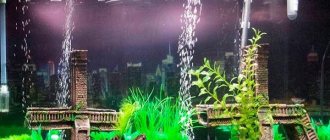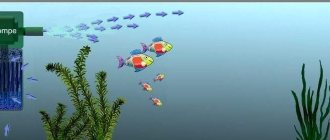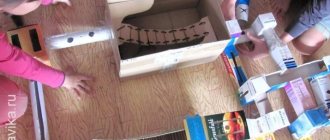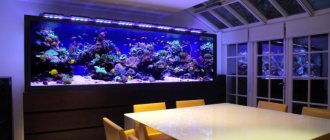Today, more and more people dream of installing an aquarium in their home. But in order for an artificial reservoir to truly delight the eye with its beauty, and for the inhabitants in it to always be healthy, it is important to make a lot of effort. Starting an aquarium for the first time is the most important stage that determines the smooth operation of it in the future, which is difficult for beginners.
Choosing the right aquarium
The size and shape of the aquarium are the main criteria that you should rely on when choosing it. Beginners should choose a rectangular pond. It is easy to maintain and comfortable for any fish. Other types - “ball”, “screen” or picture” - create additional difficulties for the aquarist to care for, because it is more difficult to create optimal conditions for gas exchange with the environment in them.
The size of the aquarium depends on how many fish you plan to place there. One of the most common mistakes among beginners is choosing a pond of small dimensions. They mistakenly believe that such an aquarium is easier to maintain. In fact, it requires more careful maintenance because small volumes of water are more sensitive to environmental changes than large volumes. Consequently, algae and bacteria begin to appear in the aquarium, which beginners often cannot cope with.
The optimal volume for beginners is 80 – 100 liters. Such an aquarium is not suitable for large animals, but several individuals of small species can comfortably fit there.
How to make the process of starting an aquarium easier?
We wrote above that for the proliferation of beneficial bacteria, food and substrate are needed. And, of course, the initial size of the bacterial colony matters. Thus, in order to speed up the maturation of the biofilter and, accordingly, the launch of the aquarium, you can immediately introduce a significant amount of bacteria into the artificial reservoir and prepare a large-area substrate for them (there is already enough food for bacteria in the starting aquarium).
Bacteria are introduced using industrially made starter cultures (we also mentioned them above) or with water, soil, or filter media from a functioning, healthy aquarium. To provide sufficient substrate area for bacteria, it is recommended to use filters with porous ceramic fillers or large-volume filters with other fillers, plant plants with narrow, feathery leaves, and use fine gravel of even size as soil. All these surfaces will be colonized by nitrifying bacteria.
Aquarium start-up control greatly facilitates the use of ammonia and nitrite tests for aquarium water. These tests are produced by different manufacturers and are not uncommon in pet stores. With their help, you can monitor the level of these toxic compounds in the water and adjust the stocking of fish in the aquarium you are starting.
As you can see, starting the aquarium correctly does not take much time - two or three weeks is quite possible. It does not require a colossal amount of strength or special academic knowledge. But it helps to avoid many problems in the future, preserves the life and health of the fish, and therefore the nerves and good mood of their owner.
Determining the location for installing the aquarium
The ideal place to place an aquarium must meet the following requirements:
- Ease of care. The aquarium must be freely accessible so that feeding the fish or changing the water does not cause any difficulties.
- No irritating factors. These include: prolonged exposure to direct sunlight, close proximity to electrical appliances (especially those that create noise - TV, radio, computer, etc.), location near the battery.
- Slight traffic of people near the reservoir. If people often walk around the aquarium, the fish may experience constant stress associated with sounds or movements. On the other hand, installing a pond in a deserted room can make pets shy and wild. In this case, it is important to maintain the golden mean by placing the aquarium in the living room, but in a place that is not easily accessible.
- Easy access to outlet. A current source is needed to connect the lamps, compressor, filter and heater.
The most common place to install an aquarium is the wall along which it is placed.
Launch. Stage four: planting
When placing living vegetation, the following recommendations should be followed:
- Large plantings are placed near the back wall.
- It is customary to plant smaller specimens in the middle part.
- In the foreground are the smallest ones, they will be closest to the observer.
Beginners should choose inexpensive, hardy plants such as valisneria or hornwort. Such specimens help to quickly establish balance, after which they can be replaced. In addition, to accelerate the stabilization of the biological balance, you can use a special bacterial starter. It is introduced into the water according to the instructions. When planting, plants should be constantly sprayed with a spray bottle.
Priming
The type of soil, its color and size not only determine the attractiveness of the reservoir, but also play an important role in the functioning of the entire aquarium ecosystem. The base for the bottom should be selected according to the following requirements:
- It should not affect the chemical composition of water, changing its hardness or acidity. The neutrality of the soil can be determined by adding it to a strong acid (for example, hydrochloric acid). Hissing during this experiment means that the soil has reacted with acid and it is better to avoid using it.
- The soil particles must provide good water circulation. Elements that are too small, as well as elements that are too large, will prevent water from penetrating to the roots of the plants. The optimal size of one particle is 1 – 5 mm.
- It should contain nutrients that, when dissolved, will feed the plants.
- The soil should be rounded, its particles should not pose a danger to fish with their sharp corners.
The most common types of soil are sand or gravel. It is better to give preference to their dark shades, because such colors absorb a large amount of heat, which has a beneficial effect on the development of plants.
It is important to remember that any soil should be purchased only in specialized stores. Because soil collected independently near artificial reservoirs may contain bacteria and infections that are dangerous to the health of fish and plants.
Installing equipment
A biological environment acceptable for the inhabitants of the aquarium is created using equipment. It provides oxygen, warmth, and creates conditions for normal life.
Filter
There are 2 large types of filters: for internal and external installation. They pass water, purifying it from mechanical impurities and toxic substances. The manufacturer indicates how much water the filter is designed for. They always take extra.
Internal filters are used mainly in small aquariums. The external ones are installed on the bedside table, only the tubes are lowered into the water. Such equipment is more efficient; it has multi-stage water purification. In addition, they are invisible and do not spoil the internal design of the aquarium.
Heater with thermostat
Heater in an aquarium.
The correct selection and installation of the heater affects the comfort of the occupants. It is entrusted with the function of maintaining the desired temperature. At the top there is a thermostat that automatically maintains the set parameters. Power is selected according to the volume of the container. The heater is completely immersed in water, and only then is it connected to electricity.
Automation cannot be completely trusted. If the heater breaks down, it is not visible visually. There are 2 dangers: the heater has burned out or the thermostat does not turn it off. To insure yourself against unpleasant consequences, install a thermometer to monitor the water temperature.
Lighting
For plants, lighting with rays of a special spectrum is important. Special lamps are installed at a rate of 6 W per 10 liters. It is better to increase the lighting intensity by 1.5 times, i.e. bring to 9 W per 10 liters of water. Additional lamps can be installed simpler, for example household fluorescent or LED.
To avoid having to turn on the lights manually, connect the light bulbs via a timer. This could be a socket with built-in automation or a special device.
Compressor
The compressor enriches the water with oxygen, which all living things breathe; it is needed for the decomposition of organic matter. It is installed outside, the tubes are lowered into the water. They are hidden behind plants, decor, under the ground so that only air bubbles rising to the top are visible. The compressor must be mounted above the water level, and if below, it must be equipped with a check valve. Otherwise, if the power goes out, water may flow into the compressor, causing it to break.
Carbonation system
Carbon dioxide saturation.
Plants need carbon dioxide to grow, especially when there are large numbers of fish. All nutrients are always present in water and appear as waste products of fish. There is never enough carbon dioxide.
Enrichment of water with it is carried out in 3 ways:
- Fermenting. An older version of this method is yeast and sugar. Today, special bottled products and all the necessary equipment are offered for sale. The contents are enough for a month.
- Chemical. Previously, soda, eggshells, lime, etc. were used. with acetic or citric acid. The reaction takes place in a special installation - a Kipp apparatus. Now they produce tablets that, when dissolved, release carbon dioxide. The method is not widely used due to the complexity of adjusting the process.
- Mechanical. They use cans, from which they fill a special bell-shaped device in the morning. The gas gradually comes out, feeding the plants. Cans with a capacity of 100-500 ml.
Stones
Stones have earned wide popularity as simple but effective decorative items. But, in addition to this, they serve as a basis for spawning, provide shelter, camouflage some technical devices and strengthen the walls of terraces.
You should choose stones that meet the following parameters:
- Do not change the chemical composition of water;
- Do not have chips or sharp edges;
- Painted in solid colors;
- Have a smooth surface (only for those stones that will be used for spawning in the future);
- There are no holes or cracks on them.
The following types of stones are often used in an aquarium:
- Basalt;
- Granite;
- Gneiss;
- Porphyry.
It is better not to use limestone, dolomite and sandstone, because they increase the hardness of the environment.
It is also advisable to purchase stones from pet stores to avoid the introduction of bacteria or infections into the aquarium. But if you plan to place a stone found in nature into a reservoir, then before doing this it must be cleaned of dirt, boiled and carefully inspected, checking for the absence of small chips or cracks.
List of required items
Before starting the aquarium for the first time, it is better to make sure that all components are prepared and awaiting installation. For convenience, you can create a checklist with all the necessary equipment. A standard beginner's kit should include:
- Aquarium. It is advisable to choose a large or medium-sized model, as it is more convenient to maintain the necessary parameters in them.
- Priming. Must ensure normal water circulation to avoid stagnation and the appearance of harmful bacteria. Pebbles, coarse sand and gravel are perfect for this. It is advisable to avoid calcium and limestone based substrates.
The soil must ensure normal water circulation - Filter. A good filter should pass through the entire volume of the aquarium at least 3-5 times per hour. This guarantees complete purification of the water from clogging.
- Replaceable filter sponges. Until a working ecosystem is established, they will be needed in large quantities to maintain the cleanliness and clarity of the water.
- Heater and thermometer. An important element of maintaining a constant temperature in the aquarium, especially if tropical fish live in it.
- Decorations and living plants.
- Water test kit. It is very important to purchase a quality test kit. This will allow you to test the quality of the liquid before introducing fish and planting. The basic kit should include tests for pH, ammonia, nitrite and nitrate.
- Siphon. With its help, you can effectively and quickly clean the aquarium soil from feces and debris. Clean soil contains less nitrates and creates more comfortable conditions for fish.
- Net. Useful for removing dead plant matter, food debris, and moving live fish.
- Scraper. Necessary for cleaning the walls from overgrown algae.
- A bucket of infused water.
After all the items from the list have been purchased, you can safely begin the launch.
driftwood
Driftwood is also used for aquarium decoration, while also providing shelter for fish.
- The tree used for decoration must be dead and free of sap. It is better to use those samples that have been in high bogs in black peat for a long time.
- Trees containing mold or rot should not be used.
- Before using branches collected from nature, they must be thoroughly cleaned of dirt, boiled, washed with running water and dried well. This will remove all the air from the pores of the wood and make it more buoyant.
Today you can buy many types of driftwood in pet stores, which can be immediately placed in the aquarium without any processing.
Heater settings
A good choice is a heater that fits comfortably into the aquarium. To heat a large volume of water, it is recommended to use two devices. There is no need to pre-prepare the heater; you can only wipe it with a damp cloth before immersing it in water. You can also check it for any violations in the integrity of the shell.
To install the heater, you just need to attach it with Velcro to the glass. It is advisable to choose a place where there is a good flow of water and the least visibility. After this you can turn it on. The recommended temperature for a regular aquarium is 23−27 degrees Celsius. A light will usually light up while the heating element is active - this will help with the heating cycling process.
Lighting
High-quality lighting is necessary not only for fish, but also for plants. When selecting such devices, you should take into account the individual characteristics of each fish, since different species need different amounts of light per day and its different intensity. Therefore, it is better to immediately populate the aquarium with animals that are similar in conditions of detention.
For lighting it is better to use fluorescent lamps. They use electricity more economically and, due to their length, cover a larger area of the aquarium.
It is better to attach lighting fixtures to the lid of the aquarium.
The optimal lamp power, suitable for most fish species, is 0.5 W per liter, and the luminous flux is 30 - 50 lm per liter.
Light and decorations
The final element of a functioning tank is light. With the right settings, it will start the process of creating bacteria to maintain the ecosystem. Having selected suitable lamps that can provide natural light in the aquarium, the aquarist needs to place them on the lid of the tank. It is important to maintain an 8-hour lighting schedule , so for convenience, you can also get a special timer.
Like all components of the aquarium, stones, artificial plants and other decorations must be thoroughly washed. In fact, all these things contain a lot of dust and dirt hidden from view.
The aquarium needs to be kept lit for 8 hours.
Heaters
Heaters are able to maintain a constant temperature in all layers of water for a long time, which is very important for fish and plants.
Today rod heaters are widely used. They are a glass flask containing a heating element. They are fixed to the wall of the reservoir using rubber suction cups or a metal support.
When choosing a heater, you should give preference to a device with a graduated scale to make it more convenient to regulate the temperature.
Putting the aquarium into operation
Preparing the aquarium for the introduction of fish is the most important stage of preparation, since it depends on it whether the ecosystem will develop or the environment will become uncomfortable for fish and plants.
It is important to monitor the ecosystem during and after the cycle. This can be done using your own freshwater testing kit. You can’t do without it if you plan to breed fancy fish species or start an aquarium with plants. In addition, the kit is necessary to monitor the condition of the water after the start. It can provide early warning of disaster and is an excellent investment that will ultimately save money on fish treatment and ecosystem restoration.
For most experienced aquarists, maintaining the functioning of the system is impossible without constant monitoring of the ongoing processes within the ecosystem.
Filtration
Without a filter, no aquarium can function. This device purifies water from foreign particles, removes dissolved organic compounds from it, promotes water circulation in the aquarium and enriches it with useful substances.
By design, filters are divided into two types:
- Airlift. It is located inside the aquarium, attached to its walls. Consists of a plastic housing, filter material, sprayer and vibration compressor. Water enters the body of the device, where it passes through the cleaning material, getting rid of foreign particles and compounds, and returns to the aquarium.
- Electromechanical filter. They can be fixed both outside and inside the aquarium. They consist of filter material and a centrifugal pump with an electric motor.
Launching fish
Introducing fish into the aquarium.
If the processes in the aquarium are going correctly, after the first week you can start the fish. They buy unpretentious species: guppies, zebrafish. The quantity is no more than a third of the total for the reservoir.
After a few days, the population is brought to half. After another week, the reservoir is completely populated.
Landing is done according to the rules:
- The water in a jar or bag with purchased fish is saturated with oxygen for several hours.
- A little water is drained and added from the aquarium. After 1 hour, repeat aeration.
- They drain and add water all the time so that it becomes like an aquarium. Then all the fish are moved into the pond.
During the first days, water tests are carried out, for which testers will be needed. The level of ammonia, nitrates, acidity is checked.
The food is first frozen or live. It is not advisable to give it dry - it can lead to a bacterial outbreak. If they give it, then little by little, fasting days are arranged.
The water is not changed at first. The need arises if the following fish behavior is observed:
- are constantly at the bottom;
- the upper fin is tucked in;
- gather in schools or swim in pairs.
Conduct rapid testing. If the water temperature is more than +25°C, the acidity exceeds 7.6, change 10-20% of the water.
To restore water balance, the fish are separated for 24 hours. During this time, the amount of ammonia decreases, after which residents are again released into the main reservoir.
Rules for a successful aquarist
- it is necessary to purchase only healthy fish from trusted stores;
- fish should not be overfed;
- It is better to regularly check how all systems are working;
- fish must have sufficient living space;
- fish living in the same system must be compatible;
- nitrogen cycle support;
- periodic filter cleaning;
- even a beginner needs to know what water hardness, pH, buffer capacity are;
- Regular partial water changes are necessary, even if the aquarium was first started less than two weeks ago.
Tips and important nuances
- It is better for beginners to try starting an aquarium from scratch using standard models. It is possible to quickly launch an aquarium with a complex configuration, but maintaining it will be difficult. It is better to purchase a more interesting container, for example, with panoramic glazing and decorative inserts later.
- A beginner should have a thermometer in his arsenal that will help track the desired temperature level. Sudden temperature changes will destroy the entire ecosystem.
- It is necessary to stock up on testers to check the chemical composition of water. are sold in specialized departments of pet stores.
- Regular cleaning of equipment will eliminate many problems.
- Aerators and filters should not be turned off even at night. The latter are washed only with water from the aquarium, and not with running water.
- Illumination is maintained for 8-10 hours.
- You should not overfeed the fish - dry food is given according to the instructions, and is not sprinkled “by eye”. Too rich a diet causes obesity, and then gas embolism.
- Regularly admiring the aquarium will not allow you to miss a possible problem within the ecosystem.
Maintaining and caring for a home aquarium, its proper organization are important processes on which the comfortable existence of pets and the aesthetic microclimate of the room depend.
To create these correct conditions, in order to avoid problems and mistakes, you need to follow simple tips for novice aquarists. The first stage concerns the choice of an aquarium. Before purchasing a house for aquatic inhabitants, it is necessary to determine its future location. The aquarium in the house should fit organically into the interior, have a wide viewing angle and a convenient approach for further use. Be in a place where the sun's rays will not disturb its surface, stand steadily.
Some models are equipped with special stands or have legs; they can be placed on the wall with the help of fasteners and occupy corner space. By design, there are three types:
- Frame products have a metal frame.
- All-glass ones have no joints or seams.
- Frameless - structures without frames and screws, glued together from glass or plexiglass.
The volume and dimensions of the tank depend on the number, size and type of aquatic pets. If there is no clear understanding yet of who will live in the aquarium, approximate calculations suggest that there is 1 cm of fish per 1 liter of water. For example, if the total length of the inhabitants is 12 cm, then the holding capacity must be at least 120 liters. Tanks with a volume of more than 100 liters imply the presence of a closed ecosystem, which will require less maintenance effort.
The pet store offers a wide selection of different forms of aquariums:
- spherical models;
- cube-shaped;
- rectangular;
- panoramic with convex glass;
- polygonal.
The optimal solution for teapots is a spacious tank with a classic rectangular shape. Moreover, its length should be greater than its height. A voluminous aquarium of the correct configuration will allow you to create a stable bacterial environment, contain a large number of fish, and take care of it without much difficulty.
The tank is installed on a smooth, level surface. There must be a soft layer between the body of the container and the area of the object on which it is installed. The edges of the aquarium should not protrude, so as not to deform and burst under the weight of the weight of water.
It is recommended to equip the first aquarium with a standard set of necessary equipment.
- Filters purify water to avoid stagnation. They are of two types: external and internal. The first is installed to filter water in spacious tanks. A small aquarium is maintained using an internal filter. They must be washed with water from the aquarium so as not to disturb the water balance inside the device. The filter material is changed every six months.
- An aerator is a device for supplying water with oxygen, which must operate around the clock (the filter may have the function of water aeration).
- A thermometer will allow you to control the temperature of the water, which will save your fish from many diseases.
- Temperature control equipment. This could be a water heater for winter and a refrigeration unit for hot weather. For novice owners, it is better to choose devices with automatic temperature control.
- Lighting devices are necessary to maintain the normal growth of not only fish, but also plants, which will allow you to recreate the natural habitat as much as possible. The power of the lamp will depend on the specific species of pets and algae.
Among the auxiliary materials you need to have a siphon for cleaning the soil, a scraper for cleaning the walls of the vessel from algae and plaque, a special feeder and a net.
If desired, cabinets or stands for storing food and necessary accessories can be purchased separately. When all the components have been purchased, we proceed to installing the aquarium. Assembly must be done on a flat surface.
Water quality
The basics of aquarium keeping are focused on testing water with special tests, with the help of which its composition and quality are determined. They are purchased at a pet store. The instructions contain precise operating information.
Before filling the container with water, it must first be prepared. It should sit for 24 hours. Do not contain impurities of chlorine and other elements. It is allowed to add special conditioners to water to improve water quality. If the liquid is too soft, more shells and pebbles are added. Hard water needs to be boiled.
Decor
A home aquarium is created taking into account the creation of a colorful landscape. This is facilitated by a variety of shelters, grottoes and decorations. The presence of snags will help the fry to hide from voracious adults.
Experts in the field of aquarium farming advise beginners to use basalt soil or rounded medium-fraction gravel. A bottom made of small particles is more difficult to clean from food debris and waste products. Its optimal thickness is from 4 to 7 cm. You can accurately determine the required layer based on the characteristics of the plants you need.
The duration of lighting per day should not exceed 12 hours. With longer work, plant growth will increase, and the life cycle of fish, on the contrary, will decrease. During the first 2 weeks, the lighting is turned on for 6–8 hours.
The water temperature for the comfortable existence of most aquatic inhabitants is 22–26°C. Depending on the specific type of inhabitants, the degree scale can range from 18–23°C for people from northern latitudes and rise to 33°C for animals and plants in tropical zones.
The water in the aquarium is replaced with clean, settled water partially every week. It is prohibited to change it in full. There is no need to change the water in the first month. The amount of new liquid in a fish aquarium should not exceed 25–30% of the total volume.
Beginner aquarists are advised to opt for unpretentious specimens:
- guppy;
- petiliah;
- mollies;
- swordtails.
They are characterized by similar behavioral norms, consume a variety of food and are quite peaceful and not picky about changes in the quality and condition of water.
Guppy.
Pecilia. Mollies. Sword bearer. You can get cardinal fish, fire barbs and zebrafish, which, if properly kept, can live up to 3 years. Catfish will help clean the bottom surface from settling food and clean off organic growth from the walls.
The main rule is not to have a large number of pets at the same time, but to observe whether everything is done correctly. To start with, you should start with no more than 8 fish in an aquarium from scratch.
We suggest you read: Causes and methods of combating stress in cats
Plants
Ease of care and maintenance is what a novice breeder needs for an aquarium. A large number of aquatic flora meet similar criteria:
- pinnate;
- hornwort;
- Vallisneria;
- elodea;
- Riccia floating.
They are not picky about temperature and water quality and require minimal illumination.
Before planting in the ground, plants purchased in the store must be treated with a solution of water with 3% hydrogen peroxide. Vegetation from natural bodies of water cannot be introduced into the aquarium. As the plant grows, it is necessary to trim it to prevent the appearance of foreign plaque.
Snails
At least two weeks must pass before starting the aquarium. After 7 days, the hardiest pets are allowed to be planted - ampullaria snails and unpretentious plants, which contribute to the faster development of the ecosystem. Based on how they feel, it’s easy to determine whether your simple aquarium is ready to accept the next batch of residents.
Aquarium care
Depending on the number of fish, the volume of the tank and the condition of the water, it is necessary to care for the aquarium at least once every 1–2 weeks. During maintenance, you need to siphon the bottom, paying attention to each area, change at least 20% of the water, clean the walls of the aquarium from plaque and algae, and wash all filter elements from contaminants.
Newbie mistakes
There are a number of common mistakes that beginners make.
Often, beginners strive to populate the aquarium with bright fish as quickly as possible and at the same time forget about the biological balance of the underwater world. As a result, a widespread pestilence begins in the water area, and pets die in a matter of days. To prevent this from happening, you need to introduce fish gradually.
Special tests will help determine the condition of the water.
Sometimes beginners do not take into account the capacity of the aquarium. The number of residents should be selected based on 2-3 liters per individual up to 5 cm (half a liter per snail). It is especially important to take this into account when starting a small aquarium of 20 or 30 liters.
There are often cases when beginners put predatory and peaceful fish in the same aquarium, chasing bright colors or unusual appearance. As a result, the fish fight, bite off each other’s fins, and predators perceive the small fish as prey.
It is desirable that these are hardy viviparous breeds that take root in less than ideal conditions. These are, for example, guppies, mollies and platies.
Request difference
It is important to take into account the difference in living conditions for different types of fish. Some breeds require harder water, others require softer water, and others even prefer warm tropical water. Therefore, you need to select species that have approximately the same care requirements.
These breeds are unpretentious and feel good even at room temperature. Minor fluctuations are not significant for them. It is important that the thermometer does not exceed 25 degrees, since being in warm water ends in the death of the fish.
Looking at the fish, you might think that they are always looking for food. But in fact, it is enough to feed them only twice a day: morning and evening. At the initial stage, patients can easily get by with one meal per day.
Excess feed should be removed with a net.
Often, after starting, beginners notice bubbles on the walls of the aquarium. This indicates that the water taken for starting was cold. When the heater began to heat it to the desired temperature, bubbles of air and steam formed.
It is not recommended to put fish in such water. You should wait until all the bubbles disappear and the temperature of the liquid reaches the required degree.
Another common mistake is insufficient water filtration. A good filter should purify the entire volume of water three times per hour. If the capacity is too large, you should think about additional installation of pump filters.
Backlighting with a power of 0.35 W/L should work 8-10 hours a day, filters and aerators - 24 hours a day. The equipment must be regularly washed with clean water and monitored for proper operation. In case of the slightest deviation, you need to replace the damaged device as soon as possible.
The mistakes of novice aquarists most often come down to untimely cleaning of artificial reservoirs, inattention to its internal and external changes, insufficient knowledge of the habitat and norms of behavior of pets. Below is a list of common mistakes.
- Incorrect launch of a new fish. Aquarium fish are placed only after the artificial pond has established itself. Purchased individuals are first placed in an aquarium together with a transport container for acclimatization. Then the water from it is gradually mixed with the liquid from the home tank.
- Incompatibility of fish. You need to get aquarium inhabitants after carefully reading the special literature for each type of pet. Some individuals may not be able to live due to different preferences for temperature, water composition or temperament. There are enough varieties of predatory individuals that it is better to settle with their own kind.
- Overfeeding fish. The mistakes of novice aquarists lie in the constant desire to satiate their pets. To begin with, it is better to feed the fish no more than once a day. Then you can do this several times during the day, but keep the portions small. Live, dry and frozen food is used for nutrition.
- Place of purchase. It is best to purchase equipment, underwater interior items, soil, necessary equipment, individuals and plants in specialized stores rather than in markets.
- Lack of proper control over the aquarium. An aquarium for a beginner is not fun, but a serious step that can lead to irreparable consequences. Before preparing the tank for launch, you need to choose a convenient installation location, equip it with the necessary equipment and test the water for quality. And only then introduce living organisms.










